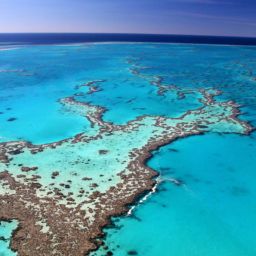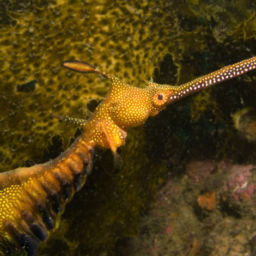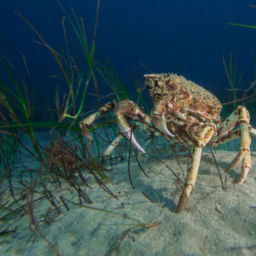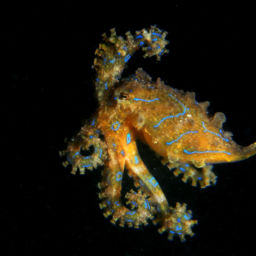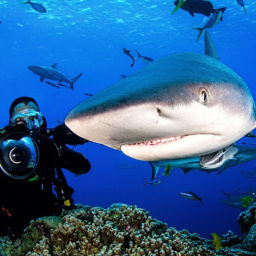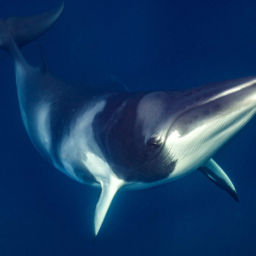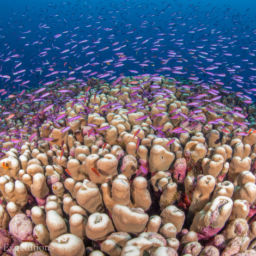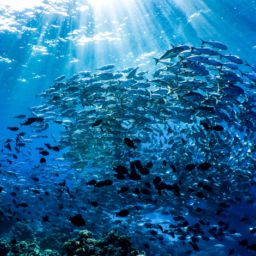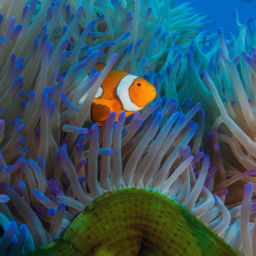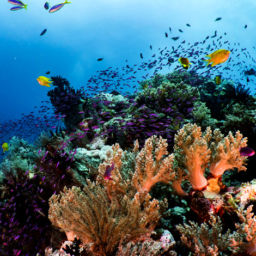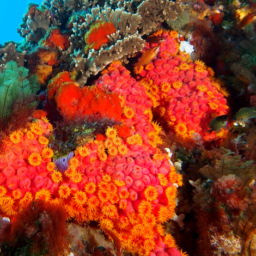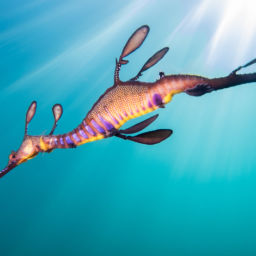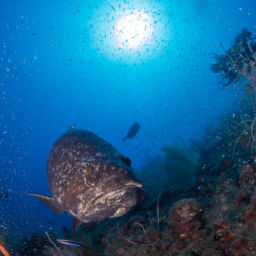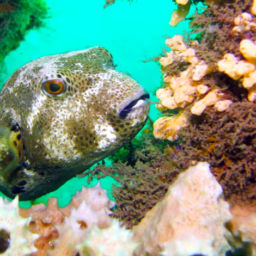“Alright, let’s go diving!”
Matt King, owner of Yongala Dive, is our captain today on the Ocean Magic. We’ve come to the coast of Townsville North Queensland to dive the wreck of the SS Yongala, and we can’t wait.
To get here, we’ve traveled south about an hour from the Townsville airport to Ayr, a tiny town and the location of our hotel. Ayr is about 20 minutes from the dive shop in Alva Beach, and we head down to the shore from the shop for the 30-minute ride out to the site, excitement building. This isn’t just any dive: the SS Yongala, which went down in 1911 during a cyclone with all 122 souls lost, is Australia’s most famous wreck. Although Matt shares a bit about the wreck’s history on the way out to the site, we can’t wait to get in the water.
Diving the SS Yongala
We gear up and giant stride off the boat, grabbing the tow line that will lead us to the mooring. There are mooring buoys just off the stern and bow of the wreck; we’ve moored at the bow. As we descend, the wreck comes into view despite the so-so visibility, and it’s teeming with life.
The 361-foot (110 m) ship lies on its starboard side in about 92 feet (28 m) of water at the bottom and 46 feet (14 m) at the top. It’s easy to circumnavigate, current permitting. Like an oasis in the desert, it’s the only large structure for miles around, so it attracts all the big boys — Queensland grouper, Maori wrasse, turtles, schooling rays, giant trevally, and whale sharks in season. As we descend, we see the outline of the ship, laying at an angle on its starboard side. The exposed deck tilts up before us from the ocean floor to the left as we face the wreck from the bow and the upended hull beckons to the right. After a quick peek in the sand near the mooring line, where Matt’s told us rays often lounge, the current today dictates that we stay mainly on the deck side.
Cyclone Yasi came through here in 2011 and wiped the century-old soft corals clean, but you’d never know it by looking at the wreck today. All manner of whip coral cover the wreck, and both hard and soft corals abound. A garden of soft purple coral, resembling stalks of kale, adorns the top-most point of the wreck. It looks almost as though it were planted there in a tidy row, along what would have been the ship’s port side railing. Flitting in and out of the coral and exposed holds are a hungry hawksbill, giant trevally and grouper, Maori wrasse, small tropical fish and undulating olive sea snakes. “You must have your eyes closed if you don’t see a sea snake on the wreck,” Yongala Dive’s skipper and dive instructor, Luke Trevitt, tells me when we return to the dive shop.
Although we’re allowed to peer into the wreck’s innards with our lights, we cannot penetrate: because the remains of the victims are still entombed inside, the site is protected as a maritime grave. Out of respect for the disaster’s victims, no one is allowed to enter or even go underneath the overhangs.
It makes no difference, however, as we’re overwhelmed by the sheer variety and volume of animals around. On our way up the mooring line for our safety stop, a giant school of barracuda materializes around us like a tornado and we all delay boarding the boat for just a little while.
I wonder why there’s such diversity on the SS Yongala and to answer that, we’ve got to backtrack a little.
The history of the SS Yongala
The SS Yongala, a passenger and freight steamer launched in 1903, ran routes around Australia, including a round trip from Fremantle in Western Australia to Brisbane, as well as a Melbourne to Cairns trip. It was on one of the latter voyages that the ship encountered a fateful storm. On March 23, 1911, while on its 99th voyage, the SS Yongala began its final journey. After unloading some cargo in MacKay, Queensland, the ship was carrying 49 passengers, 73 crew members and a racehorse named Moonshine as it headed directly into a cyclone on the way to Townsville.
The local signal station received a telegram warning of the cyclone brewing between MacKay and Townsville, and subsequently sent both flag and wireless signals. The SS Yongala captain, however, did not see the flags and the boat did not have wireless equipment. At approximately 6:40 pm, five hours after leaving MacKay, the lighthouse keeper at Dent Island saw the ship sail into the Whitsunday Passage — the last confirmed sighting. At some point on March 24th, 1911, the ship succumbed to the storm and sank with all 122 passengers on board.
When the SS Yongala didn’t appear in Townsville on schedule, it was assumed that it sought shelter from the storm and was just late to arrive. It wasn’t until three other ships arrived in Townsville that the SS Yongala was declared missing on March 26th. Although wreckage washed ashore, the only body that searchers found was that of Moonshine, the horse who’d been aboard when the boat sank.
Discovery of the SS Yongala
The wreckage of the SS Yongala remained undiscovered until 1943, when a Navy minesweeper fouled on an obstruction in the shipping lanes between Brisbane and Townsville. After WWII ended, survey ship HMS Lachlan investigated the unknown object in 1947. The Lachlan steamed over the area several times, determining that the object was about 300 feet (91 m) long and likely a shipwreck. Although the only ship reported missing in the area was the SS Yongala, the Navy did not follow up on the information.
In 1958, local fisherman Bill Kirkpatrick relocated the wreck, hoping to make a salvage claim. Although unsuccessful, he did agree to take researchers and a professional diver to the site. The group retrieved the SS Yongala’s safe, and although it contained nothing but black sludge, the partial serial number on its surface positively identified the long-lost vessel as the SS Yongala in 1961. Since discovery, the ship has become one of Australia’s most popular dive sites, with thousands visiting each year.
And to answer my earlier question of why the wreck is host to so much marine life, it’s thanks to the SS Yongala’s position underwater. The ship sank in an ideal spot for attracting animals. “The location of the wreck helps a lot because it’s close to the estuaries and it’s close to the reef — sort of situated in between,” says Matt when I ask him about it. “But it’s almost open ocean as well, so it’s the perfect location for pelagics too.”
World-class wreck
Our next few days on the site prove just as fruitful as the first. We see a gigantic Queensland grouper surrounded by a constellation of little fish, as though it were the sun and the fish were the stars. So many fish surround the grouper, in fact, that it appears almost as a shadow. One morning, when the current permits us to patrol the hull side of the wreck, we spot a guitarfish in the shallows, just off the port side.
Spadefish getting cleaned face straight up to the surface, their mouths agape as small cleaner fish flit in and out. Giant turtles are commonplace, and baitfish swarm the superstructure so thickly that making out the metal beneath is difficult. “We had a serious complaint about that,” Luke tells me. “Someone said they couldn’t see the wreck, so they didn’t want to do the second dive. There were too many fish.”
After multiple fantastic dives on the SS Yongala, I ask Matt what he thinks makes this site so special.
“It’s got to be the fish life, doesn’t it?” he says, echoing Luke. “The abundance of marine life you can see on one dive is like no other place.”
After three days on the wreck and sightings of everything from a guitarfish to a Queensland grouper, Maori wrasse and more olive sea snakes than I could count, I can’t help but agree.
Make it happen
The best way to visit the SS Yongala is to use Ayr as a home base. If you’re flying into Townsville, you can rent a car at the airport and get to Ayr in about an hour, where you’ll find several motels. From Ayr, it’s about a 20-minute drive from Alva Beach, the location of Yongala Dive and your best bet for day trips out to the wreck. From Alva Beach, it’s about a 30-minute boat ride out to the wreck. You’ll dive the site twice, with no time-limit restrictions on the dives, and then head back to the dive shop for an included BBQ lunch.
You can still dive the SS Yongala if you’re staying in Townsville, though getting there will take about three hours by boat instead of 30 minutes from Ayr. Because of the wreck’s depth and the likely presence of currents on the site, it’s best for experienced divers.

















